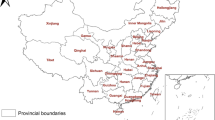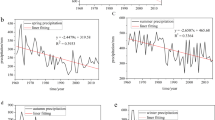Abstract
The trends of the precipitation acidity from 1992 to 2006 were studied, based on the long-term acid rain observations at 74 sites in China. The results show that there was no remarkable change or extension of acid rain area (i.e., with annual mean of precipitation pH<5.6) during the 15 years. The largest and continuous acid rain area exists in the south of the Yangtze River, while the acid rain areas north of the Yangtze River remain separate. The severe acid rain area (i.e., with annual mean of precipitation pH<4.5) exists mainly in the south of the Yangtze River. The overall precipitation acidity for the 74 stations showed different trends before 1999 and after 2000. In the period 1992–1999, the precipitation acidity at most of the sites remained steady or showed a decreasing trend. After 2000, however, an increasing trend of the precipitation acidity was observed at many sites in North China, Central China, East China, and South China. As a result, the pattern of acid rain area changed during 1992–2006. The precipitation over North China, Central China, and South China became more acidified in the 15 years, with more pronounced trends in North China and the north of Central China. A slight decrease in the precipitation acidity was found in Southwest China, an area characterized as severest acid rain area for about two decades after the early 1980s. Consequently, the center of severe acid rain area in the south of the Yangtze River moved eastwards. The non-hydrogen conductivity (NHC), which is defined as the difference between the measured precipitation conductivity and the H+ conductivity calculated from measured pH, was estimated and treated as a proxy of soluble ions in precipitation. The result shows that the overall trend of the NHC before 1999 was pronounced and positive, while the trend after 2000 was inconspicuous or slightly negative. During 2000–2006, the change rate of pH was positively correlated to that of the NHC at 21 sites, implying that the increasing acidities found at these sites may partly be attributed to the decrease in the concentration of airborne particulate matter in recent years.
Similar content being viewed by others
References
Li H Z, Wang M L. Some preliminary studies of acid precipitation in China (in Chinese). Acta Meteorol Sin, 1984, 42: 332–339
Wang W X, Wang T. On the origins and trends of acid precipitation in China. Water Air Soil Pollution, 1995, 85: 2295
Ding G A, Xu X B, Fang X M, et al. The current status and trends of acid rain in China (in Chinese). Chinese Sci Bull, 1997, 42: 169–173
Ding G A, Xu X B, Wang S F, et al. Database from the acid rain network of China Meteorological Administration and its preliminary analysis (in Chinese). J Appl Meteorol Sci, 2004, 15(Suppl): 85–94
Wang W X, Xu P J. Research progress in precipitation chemistry in China (in Chinese). Prog Chem, 2009, 21: 266–281
Liu B J, Hao J M, He K B. Study on designation of acid rain and SO2 pollution control areas and policy implementation (in Chinese). Acta Sci Circumst, 1998, 18: 1–7
Zhang C Y, Wang S X, Xing J, et al. Current status and future projections of NOx emissions from energy related industries in China (in Chinese). Acta Sci Circumst, 2008, 28: 2470–2479
Gong Y G, Su H, Cheng Y F, et al. Analysis on concentration and source rate of precursor vapors participating in particle formation and growth at Xinken in the Pearl River Delta of China. Adv Atmos Sci, 2008, 25: 427–436
Huang Y L, Wang Y L, Zhang L P. Long-term trend of chemical composition of wet atmospheric precipitation during 1986–2006 at Shenzhen city, China. Atmos Environ, 2008, 42: 3740–3750, doi: 10.1016/j.atmosenv.2007.12.063
Tang J, Xu X B, Ba J, et al. Trend of precipitation acidity in Beijing-Tianjin region — the implication of particle abatement effort (in Chinese). J Grad School Chin Acad Sci, 2007, 24: 667–673
Jin L, Xu Q, Lin A G, et al. Trend analysis of wet deposition between 1987–2004 in Beijing city (in Chinese). Acta Sci Circumst, 2006, 26: 1195–1202
Tang J, Xu X B, Yang Z B, et al. The conductivity additivity of ionic components in precipitation and its application to the data evaluation of acid rain monitoring (in Chinese). J Appl Meteorol Sci, 2008, 19: 1–8
China Meteorological Administration. Manual for Acid Rain Monitoring (in Chinese). 2nd ed. Beijing: China Meteorological Administration, 1992
China Meteorological Administration. Standard Operation Manual for the Acid Rain Monitoring (in Chinese). Beijing: Meteorological Publishing House, 2005
Tang J, Cheng H B, Yu X L, et al. Evaluation of results of station inter-comparison with blind samples in Acid Rain Monitoring Network in China (in Chinese). Meteorol Monthly, 2007, 33: 75–83
Ba J. Study on the long-term trend and spatio-temporal distribution of acid rain over China (in Chinese). Thesis for M.S. Degree. Beijing: Chinese Academy of Meteorological Sciences, 2008. 8–22
Tang J Yu X M Cheng H B, et al The analysis on the negative bias of pH measurement in acid rain monitoring (in Chinese). J Appl Meteorol Sci, 2010 (in press)
US-EPA. EPA/240/B-06/003, Data Quality Assessment: Statistical Methods for Practitioners /EPA QA/G-9S. 2006
Richter A, Burrows J P, Nüß H, et al. Increase in tropospheric nitrogen dioxide over China observed from space. Nature, 2005, 437: 129–132, doi: 10.1038/nature04092
Xu J, Zhang X L, Xu X B, et al. Variations and source identification of chemical compositions in wet deposition at Shangdianzi background station (in Chinese). Acta Sci Circumst, 2008, 28: 1001–1006
Yang F M, He K B, Lei Y, et al. Chemical characters of atmospheric precipitation in Beijing in years of 2001-2003 (in Chinese). Chin Environ Sci, 2004, 24: 538–541
Hu M, Zhang J, Wu Z J. Chemical compositions of precipitation and scavenging of particles in Beijing. Sci China Ser B-Chem, 2005, 48: 265–272
Tang A H, Zhuang G S, Wang Y, et al. The chemistry of precipitation and its relation to aerosol in Beijing. Atmos Environ, 2005, 39: 3397–3406, doi: 10.1016/j.atmosenv.2005.02. 001
Zeng F G, Wang W, Yang Z F, et al. Study and analysis of acidifying buffer capacity of aerosols (in Chinese). Environ Monitor Chin, 2001, 17: 13–17
Wang W, Tang D G, Liu H J, et al. Research on current pollution status and characteristics of PM2.5 in China (in Chinese). Res Environ Sci, 2000, 13: 1–5
Author information
Authors and Affiliations
Corresponding author
About this article
Cite this article
Tang, J., Xu, X., Ba, J. et al. Trends of the precipitation acidity over China during 1992–2006. Chin. Sci. Bull. 55, 1800–1807 (2010). https://doi.org/10.1007/s11434-009-3618-1
Received:
Accepted:
Published:
Issue Date:
DOI: https://doi.org/10.1007/s11434-009-3618-1




